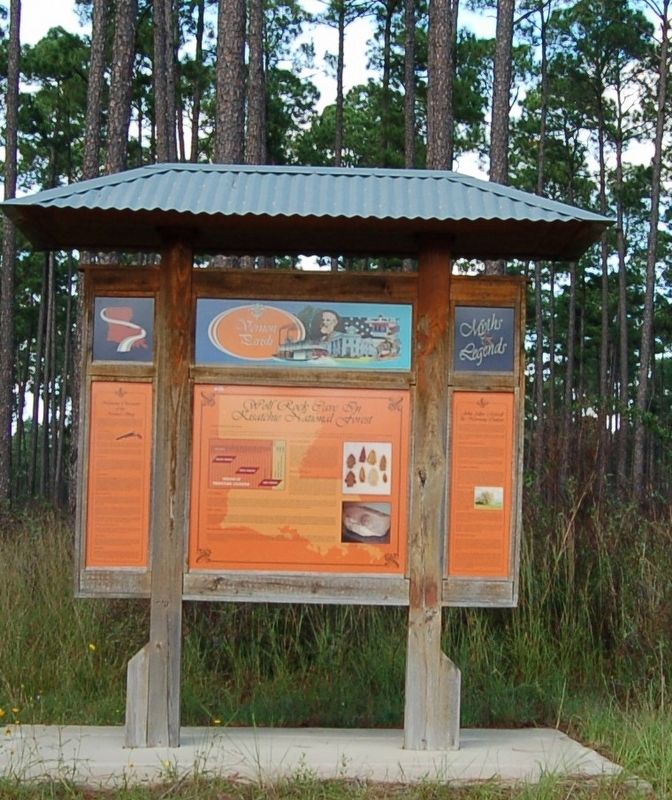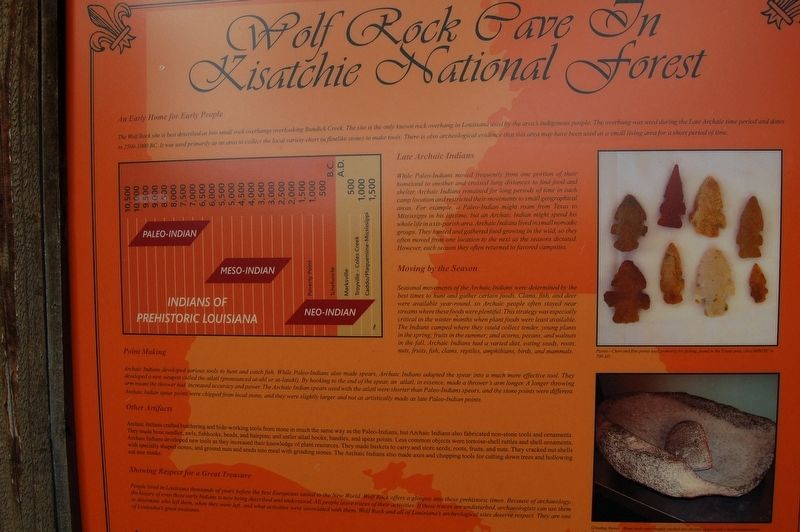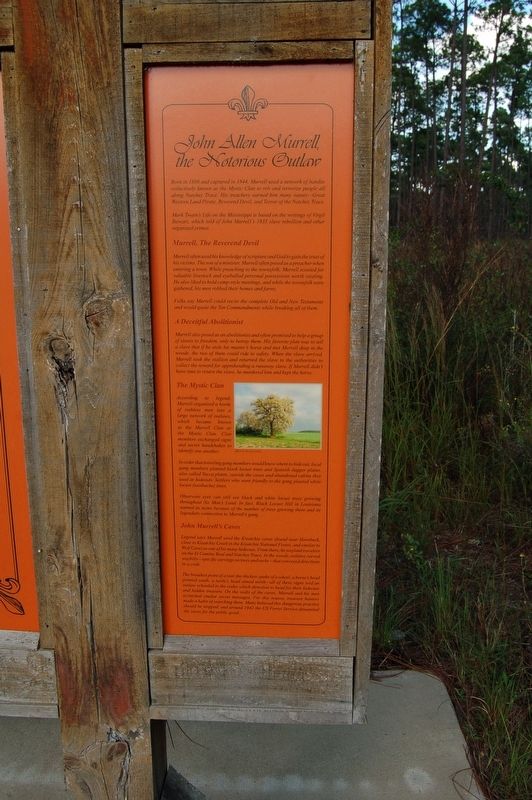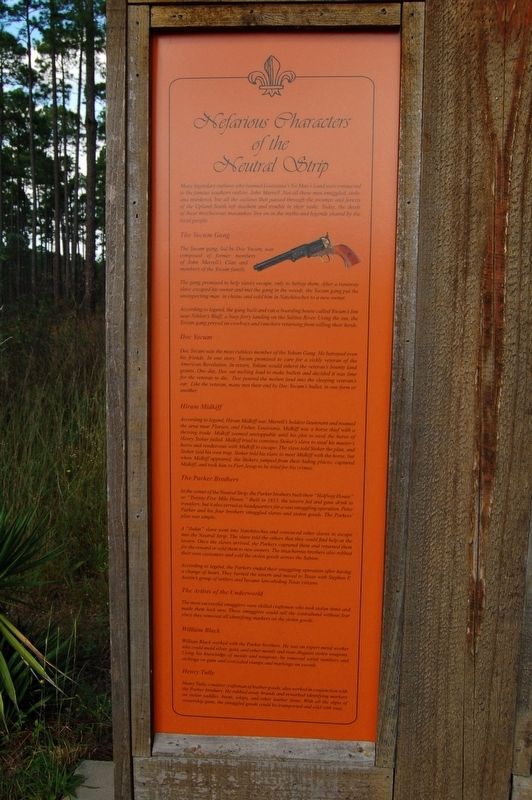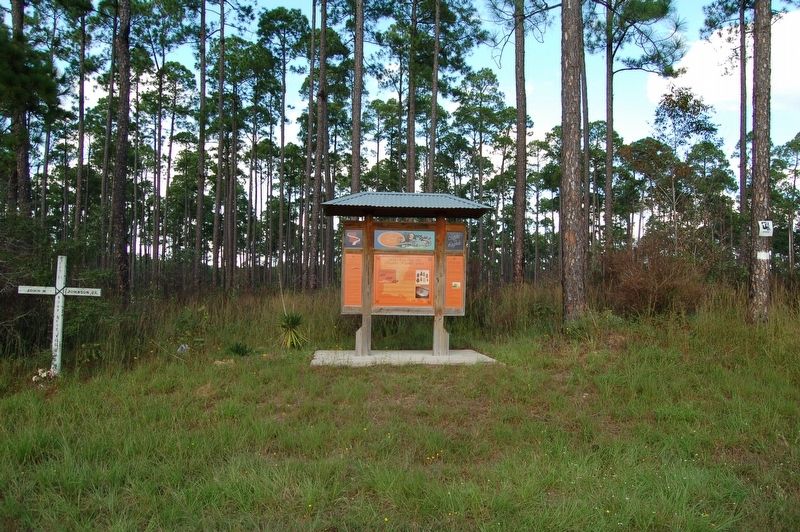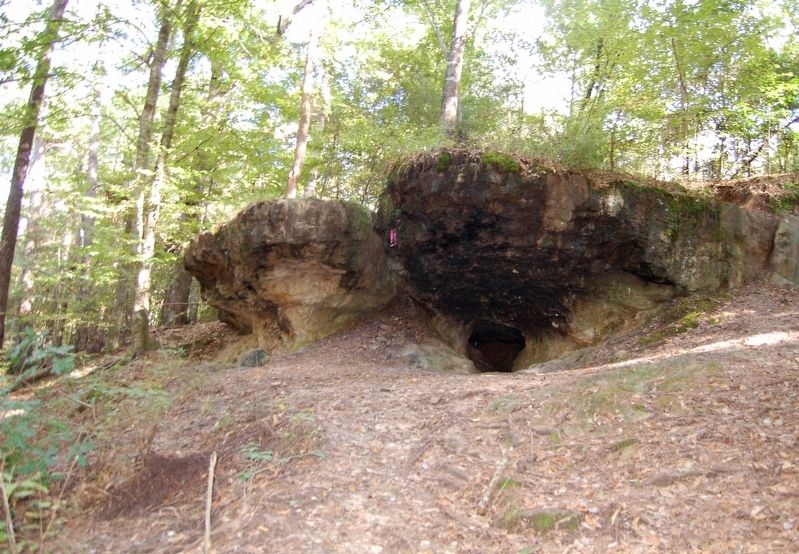Leesville in Vernon Parish, Louisiana — The American South (West South Central)
Wolf Rock Cave In Kisatchie National Forest
Myths and Legends - Vernon Parish
Inscription.
An Early Home for Early People
The Wolf Rock site is best described as two small rock overhangs overlooking Bundick Creek. The site is the only known rock overhang in Louisiana used by the area's indigenous people. The overhang was used during the Late Archaic time period and dates to 2500-1000 BC. It was used primarily as an area to collect the local variety chert (a flintlike stone) to make tools. There is also archeological evidence that this area may have been used as a small living area for a short period of time.
Late Archaic Indians
While Paleo-Indians moved frequently from one portion of their homeland to another and crossed long distances to find food and shelter, Archaic Indians remained for long periods of time in each camp location and restricted their movements to small geographical areas. For example, a Paleo-Indian might roam from Texas to Mississippi in his lifetime, but an Archaic Indian might spend his whole life in a six-parish area. Archaic Indians lived in small nomadic groups. They hunted and gathered food growing in the wild, so they often moved from one location to the next as the seasons dictated. However, each season they often returned to favored campsites.
Moving by the Season
Seasonal movements of the Archaic Indians were determined by the best times to hunt and gather certain foods. Clams, fish, and deer were available year-round, so Archaic people often stayed near streams where these foods were plentiful. This strategy was especially critical in the winter months when plant foods were least available. The Indians camped where they could collect tender, young plants in the spring; fruits in the summer; and acorns, pecans, and walnuts in the fall. Archaic Indians had a varied diet, eating seeds, roots, nuts, fruits, fish, clams, reptiles, amphibians, birds, and mammals.
Poing Making
Archaic Indians developed various tools to hunt and catch fish. While Paleo-Indians also made spears, Archaic Indians adapted the spear into a much more effective tool. They developed a new weapon called the atlatl (pronounced at-uhl or at-latuhl). By hooking to the end of the spear, an atlatl, in essence, made a thrower's arm longer. A longer throwing arm meant the thrower had increased accuracy and power. The Archaic Indian spears used with the atlatl were shorter than Paleo-Indians spears, and the stone points were different. Archaic Indian spear points were chipped from local stone, and they were slightly larger and not as artistically made as late Paleo-Indian points.
Other Artifacts
Archaic Indians crafted butchering and hide-working tools from stone in much the same
way as the Paleo-Indians, but Archaic Indians also fabricated non-stone tools and ornaments.
They made bone needles, awls, fishhooks, beads, and hairpins; and antler atlatl hooks, handles, and spear points. Less common objects were tortoise-shell rattles and shell ornaments.
Archaic Indians developed new tools as they increased their knowledge of plant resources. They made baskets to carry and store seeds, roots, fruits, and nuts. They cracked nut shells
with specially shaped stones, and ground nuts and seeds into meal with grinding stones. The Archaic Indians also made axes and chopping tools for cutting down trees and hollowing
out tree trunks.
Showing Respect for a Great Treasure
People lived in Louisiana thousands of years before the first Europeans sailed to the New World. Wolf Rock offers a glimpse into these prehistoric times. Because of archaeology. the history of even these early Indians is now being described and understood. All people leave traces of their activities. If these traces are undisturbed, archaeologists can use them to determine who left them, when they were left, and what activities were associated with them. Wolf Rock and all of Louisiana's archeological sites deserve respect. They are one of Louisiana's great treasures.
John Allen Murrell, the Notorious Outlaw
Born in 1806 and captured
in 1844, Murrell used a network of bandits
collectively known as the Mystic Clan to rob and terrorize people all
along Natchez Trace. His treachery earned him many names-Great
Western Land Pirate, Reverend Devil, and Terror of the Natchez Trace.
Mark Twain's Life on the Mississippi is based on the writings of Virgil Stewart, which told of John Murrell's 1835 slave rebellion and other organized crimes.
Murrell, The Reverend Devil
Murrell often used his knowledge of scripture and God to gain the trust of his victims. The son of a minister, Murrell often posed as a preacher when entering a town. While preaching to the townsfolk, Murrell scouted for valuable livestock and eyeballed personal possessions worth stealing. He also liked to hold camp-style meetings, and while the townsfolk were gathered, his men robbed their homes and farms.
Folks say Murrell could recite the complete Old and New Testaments and would quote the Ten Commandments while breaking all of them.
A Deceitful Abolitionist
Murrell also posed as an abolitionist and often promised to help a group of slaves to freedom, only to betray them. His favorite plan was to tell a slave that if he stole his master's horse and met Murrell deep in the woods, the two of them could ride to safety. When the slave arrived, Murrell took the stallion and returned the slave to the
authorities to
collect the reward for apprehending a runaway slave. If Murrell didn't
have time to return the slave, he murdered him and kept the horse.
The Mystic Clan
According to legend, Murrell organized a horde of ruthless men into a large network of outlaws, which became known as the Murrell Clan or the Mystic Clan. Clan members exchanged signs and secret handshakes to identify one another.
In order that traveling gang members would know where to hide out, local gang members planted black locust trees and Spanish dagger plants, also called Yucca plants, outside the caves and abandoned cabins they used as hideouts. Settlers who were friendly to the gang planted white locust (toothache) trees.
Observant eyes can still see black and white locust trees growing throughout No Man's Land. In fact, Black Locust Hill in Louisiana earned its name because of the number of trees growing there and its legendary connection to Murrell's gang.
John Murrell's Caves
Legend says Murrell used the Kisatchie caves (found near Hornbeck, close to Kisatchie Creek in the Kisatchie National Forest, and similar to Wolf Cave) as one of his many hideouts. From there, he waylaid travelers on the El Camino Real and Natchez Trace. In the woods, outlaws carved waybills-specific carvings on trees and rocks-that conveyed directions in a code.
The
broadest point of a star, the thickest spoke of a wheel, a horse's head
pointed south, a turtle's head aimed north-all of these signs told an
outlaw schooled in the codes which direction to head for their hideouts
and hidden treasure. On the walls of the caves, Murrell and his men
scratched similar secret messages. For this reason, treasure hunters
made a habit of searching them. Many believed this dangerous practice
should be stopped, and around 1942 the US Forest Service dynamited
the caves for the public good.
Nefarious Characters of the Neutral Strip
Many legendary outlaws who roamed Louisiana's No Man's Land were connected to the famous southern outlaw, John Murrell. Not all these men smuggled, stole, and murdered, but all the outlaws that passed through the swamps and forests of the Upland South left mayhem and trouble in their wake. Today, the deeds of these mischievous marauders live on in the myths and legends shared by the local people.
The Yocum Gang
The Yocum gang, led by Doc Yocum, was composed of former members of John Murrell's Clan and members of the Yocum family.
The gang promised to help slaves escape, only to betray them. After a runaway slave escaped his owner and met the gang in the woods, the Yocum gang put the unsuspecting man in chains and sold him in Natchitoches to a new owner.
According to legend, the gang built and ran a boarding house called Yocum's Inn near Niblett's Bluff, a busy ferry landing on the Sabine River. Using the inn, the Yocum gang preyed on cowboys and ranchers returning from selling their herds.
Doc Yocum
Doc Yocum was the most ruthless member of the Yokum Gang. He betrayed even his friends. In one story. Yocum promised to care for a sickly veteran of the American Revolution. In return, Yokum would inherit the veteran's bounty land grants. One day, Doc sat melting lead to make bullets and decided it was time for the veteran to die. Doc poured the molten lead into the sleeping veteran's ear. Like the veteran, many met their end by Doc Yocum's bullet, in one form or another.
Hiram Midkiff
According to legend, Hiram Midkiff was Murrell's boldest lieutenant and roamed the area near Florien, and Fisher, Louisiana. Midkiff was a horse thief with a thriving trade. Midkiff seemed unstoppable until his plot to steal the horse of Henry Stoker failed. Midkiff tried to convince Stoker's slave to steal his master's horse and rendezvous with Midkiff to escape. The slave told Stoker the plan, and Stoker laid his own trap. Stoker told his slave to meet Midkiff with the horse, but when Midkiff appeared, the Stokers jumped from their hiding places, captured Midkiff, and took him to Fort Jesup to be tried for his crimes.
The Parker Brothers
In the center of the Neutral Strip, the Parker brothers built their "Halfway House" or "Twenty-Five Mile House." Built in 1813, the tavern fed and gave drink to travelers, but it also served as headquarters for a vast smuggling operation. Peter Parker and his four brothers smuggled slaves and stolen goods. The Parkers' plan was simple.
A "Judas" slave went into Natchitoches and convinced other slaves to escape into the Neutral Strip. The slave told the others that they could find help at the tavern. Once the slaves arrived, the Parkers captured them and returned them for the reward or sold them to new owners. The treacherous brothers also robbed their own customers and sold the stolen goods across the Sabine.
According to legend, the Parkers ended their smuggling operation after having a change of heart. They burned the tavern and moved to Texas with Stephen F. Austin's group of settlers and became law-abiding Texas citizens.
The Artists of the Underworld
The most successful smugglers were skilled craftsmen who took stolen items and made them look new. These smugglers could sell the contraband without fear since they removed all identifying markers on the stolen goods.
William Black
William Black worked with the Parker brothers. He was an expert metal worker who could mold silver, gold, and other metals and even disguise stolen weapons. Using his knowledge of metals and weapons, he removed serial numbers and etchings on guns and concealed stamps and markings on swords.
Henry Tully
Henry Tully, a master craftsman of leather goods, also worked in conjunction with the Parker brothers. He rubbed away brands and reworked identifying markers on stolen saddles, boots, whips, and other leather items. With all the signs of ownership gone, the smuggled goods could be transported and sold with ease.
Erected by Louisiana Myths and Legends Trail.
Topics and series. This historical marker is listed in these topic lists: Natural Features • Parks & Recreational Areas. In addition, it is included in the Louisiana Myths & Legends Byway series list.
Location. 31° 0.264′ N, 93° 10.954′ W. Marker is in Leesville, Louisiana, in Vernon Parish. Marker is on Pitkin Highway (Highway 10) near usfs 421 Road, on the right when traveling north. Touch for map. Marker is in this post office area: Leesville LA 71446, United States of America. Touch for directions.
Other nearby markers. At least 8 other markers are within 4 miles of this marker, measured as the crow flies. Louisiana Maneuvers Louisiana Goes to War, Twice (approx. one mile away); Civilian Conservation Corps (approx. 1.2 miles away); Wolf Rock Cave (approx. 2.3 miles away); The Seventh Armored Division (approx. 3.1 miles away); Camp Polk Heritage Families (approx. 3˝ miles away); Peason Ridge Heritage Families (approx. 3˝ miles away); Second Brigade Soldiers (approx. 3˝ miles away); 5th Infantry Division (Mechanized) (approx. 3˝ miles away). Touch for a list and map of all markers in Leesville.
Credits. This page was last revised on November 24, 2022. It was originally submitted on November 24, 2022, by Cajun Scrambler of Assumption, Louisiana. This page has been viewed 676 times since then and 105 times this year. Photos: 1, 2, 3, 4, 5, 6. submitted on November 24, 2022, by Cajun Scrambler of Assumption, Louisiana.
